1.01 Minnesota Fats — WR Calvin Johnson |
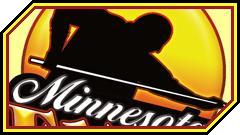 |
| After a game where the Fats’ starting wideouts had no receptions between them, Minnesota now has three that should get plenty—Santana Moss, Terrell Owens (acquired in a trade with Houston for the second pick) and now Calvin Johnson. Johnson is a huge acrobatic receiver with tremendous ball skills and body control. He is capable of going up and getting the ball over many cornerbacks. He is also a beast in the red zone. On top of it, he has freaky speed for his size—4.35 at the Combine (incredibly fast for a 239-pounder, and he was wearing borrowed sneakers, too, according to Scouts, Inc.’s Todd McShay). Wonder why he didn’t have a 1,000-yard season before 2006? Well, the QB he played with while at GT (Reggie Ball) wasn’t one of the better college QBs around. Bottom line, he’s the best WR available to draft in TUFF Rookie Draft history. ESPN’s Sean Salisbury calls him the closest thing to a guarantee in this year’s draft. |
1.02 Denver Devils — RB Adrian Peterson |
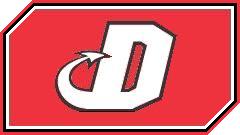 |
| AP has a great combination of size, speed and shiftiness, and aside from his durability concerns and short-term job situation, he’s the best RB available this year. Besides, the job situation isn’t a big deal for the Devils, who already have Reggie Bush and the Giants’ running backs. If Peterson is able to prove right away that he doesn’t have to share carries with Chester Taylor on the Vikings, that’s a bonus. This pick was traded three times—first to Minnesota last season (for RBs Travis Henry and Chris Brown), then to Houston (for Terrell Owens and a #1 in 2008) and now to Denver (with a late second-round pick for RB Rudi Johnson). |
1.03 Cleveland Cellar Dwellers — RB Marshawn Lynch |
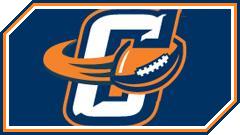 |
| The Cellar Dwellers began rebuilding their team a year ago by trading its two top WRs (Javon Walker and Steve Smith) for two rookies (RB Jerious Norwood, TE Marcedes Lewis) and a few top draft picks. As a result, Cleveland has three first-round picks this year. And they are lucky enough to use the first on a player that might go #1 in some (if not most) rookie drafts this year. Lynch wowed the nation in his first year (2004) by getting 628 yards and 8 TD despite never getting more than 9 carries in any game. Although Adrian Peterson is considered a better back than Lynch, Lynch landed into a job situation where the job is clearly his to lose, not having to share carries with a veteran as AP will with Chester Taylor. |
1.04 Tampa Bay Meat Goats — QB Brady Quinn |
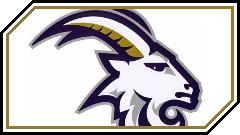 |
| Scott Wright of NFL Draft Countdown says: “Quinn really is the total package and has everything you look for both mentally and physically”—meaning size, skills, decision-making, and intangibles. He was the best QB Notre Dame had since Joe Montana. Tampa Bay took him over the stronger-armed JaMarcus Russell, citing Charlie Weis’ track record in developing quarterbacks. Tom Brady, the Meat Goats’ current starting QB, knows all about that—he worked with Weis when Weis was the Patriots’ offensive coordinator. |
1.05 Detroit Vipers — RB Brandon Jackson |
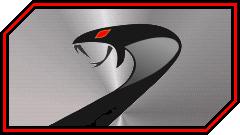 |
| While VP of football operations for the Seattle Seahawks (2000-04), Ted Thompson drafted 9 of the players that started for Seattle in Super Bowl XL, most notably RB Shaun Alexander. Now GM of the Green Bay Packers, Thompson’s in the process of bringing respectability back to the Pack, as Green Bay improved from 4-12 to 8-8 last year. I'm not about to doubt his selection of Jackson; frankly, I'm thrilled to be able to address a long-standing need with the #5 pick, something I thought impossible prior to the NFL Draft. Scouts, Inc. thinks Jackson just needs more experience and strength, calling him "an instinctive, shifty and tough runner with the size-potential to emerge as a good starter in a zone-blocking scheme.” Green Bay switched to that scheme last year. Jackson has had two shoulder surgeries in two years, so durability is an issue. Gil Brandt of NFL.com (and a former scouting director with the Dallas Cowboys) says: “Jackson has a chance to be the real surprise of this draft, as far as running backs go. He reminds me of Frank Gore and Rudi Johnson... he’s a complete back.” |
1.06 Carolina Convicts — RB Chris Henry
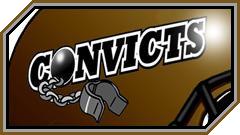 |
|
| Carolina actually missed out on the #1 pick by seven points—they beat Detroit by 1 point in Week 1, Arizona by 4 points in Week 4, and Minnesota by 2 in Week 9. Had Carolina lost those three games, they would be picking #1. They needed help at RB desperately—their top producer at the position was third-down back Leon Washington. Enter Chris Henry, who declared early due to playing time issues, plus he didn’t like the new spread offense that will be installed at Arizona this fall. Consensus Draft Services says: “Chris has ALL the goods. 6’0.5", 230, very fast (4.40 at the Combine), and he is a good blocker and a very, very good receiver. The only thing Chris lacks is impressive college production, but that can be explained by his lack of playing time in 2005—when he was the understudy for Mike Bell—and by the fact that Arizona opened ‘06 with three freshmen and 2 sophomores on the offensive line.” In addition to his size-speed ratio, Henry has another thing going for him: The only man ahead of him on the Titans’ depth chart at running back is LenDale White, who has weight and character issues. |
1.07 Tennessee Taz Devils — RB Michael Bush
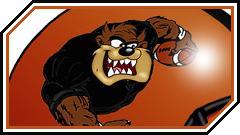 |
|
| Taz Devils owner Georgia native Lonnie Daniel dreamed of getting Georgia Tech WR Calvin Johnson to improve the weakest spot on his team. But then Johnson did so well that there was no way that he would fall to the Taz. Still, Daniel was able to get a terrific handcuff pick here. Bush was among the NCAA’s leading scorers in 2005, a year after sharing the rock with Eric Shelton. He could have come out then, but opted for stay and help Louisville go after a national title. Then Bush broke his leg in the season opener against Kentucky, and he was slow to recover from the surgery he had at that time. But a recent second surgery to replace a titanium rod in the leg appears to be just what the doctor ordered. Bush, a former high school QB, is still developing as a runner, and still learning his size as leverage and to advantage. One more note—if LaMont Jordan struggles again this year, the Raiders won’t want to pay his 2008 salary, so Bush could replace him in 2008. |
1.08 Green Bay Ground Hogs — WR Robert Meachem
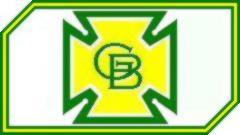 |
|
| One of the fastest wideouts at the Combine, Meachem gives the Saints the speedy big-play threat to replace the departed Joe Horn. He and Marques Colston could complement each other as starters. GB acquired this pick (along with 1.14 and WR Greg Jennings) from Pittsburgh in exchange for a receiver that most thought would be a fixture with the Ground Hogs for years, WR Roy Williams. |
1.09 Indianapolis Hoosier Daddy’s — QB JaMarcus Russell
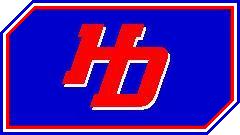 |
|
| Indy has turned from a laughingstock (2004) into a darkhorse contender for the AFC title, and it’s because two of their recent draft picks have paid huge dividends (Frank Gore two years ago, Maurice Jones-Drew last year). And their QB of the future almost fell into their laps, except that Cleveland GM Derek Maddox managed to convince Indy to trade up to get their guy. His draft stock rose dramatically after he handed Brady Quinn’s butt to him at the 2007 Sugar Bowl, and declaring a year early was a no-brainer where the big money is concerned. He led LSU to eight comeback victories during his career. But above all, he went earlier than Quinn in the NFL Draft for one simple reason: A better physical skills set (comparable size to Daunte Culpepper, and more importantly, fantastic arm strength). |
1.10 Cleveland Cellar Dwellers — RB Kenny Irons
 |
|
| Irons battled nagging injuries as a senior and saw his stock drop after a great 2005 season. Which Irons will show up—last year’s dinged-up model or the nimble 2005 one? Only time will tell, as he'll back up Rudi Johnson for the time being (Houston might have considered him at 1.15 as a handcuff, but they were thinking WR anyway). One thing is sure—the Bengals’ selection of Irons is a resounding vote of “no confidence" against oft-injured Chris Perry. |
1.11 Cleveland Cellar Dwellers — WR Dwayne Bowe
 |
|
| Bowe was a standout during Senior Bowl week. Now he gets himself into a great job situation in Kansas City, where pretty much the only guy ahead of him in the pecking order is aging Eddie Kennison. One thing Bowe did in July 2006 that maybe Michael Clayton (another LSU alumnus) should look into: Lasik eye surgery. Bowe said, “It was a great thing for me. I'm glad I got it done. I can see the ball clearer … I had a problem, I corrected it and I've been on a roll.” And I'm very sure that Cleveland would have taken Irons and Bowe anyway. Maddox made a great move, similar to the Lions’ trading down to get Roy Williams in 2004. The only better move was my trading down to get Brandon Jac... oh, no, wait, I actually WON some games to move down, darnit! |
1.12 Denver Devils — TE Greg Olsen
 |
|
| Denver’s already got one of the league’s top tight ends in Jeremy Shockey, but they decided to bring in another tight end from “The U,” Greg Olsen. He raised his draft stock big time at the Combine when he ran the 40 in 4.51 seconds—0.2 seconds faster than the next-best tight end. While he’s not the freak of nature that Vernon Davis is, he comes from a program that has turned out some solid TEs in recent years (Shockey, Bubba Franks, Kellen Winslow II). |
1.13 Minnesota Fats — RB Tony Hunt
 |
|
| Hunt pretty much improved in each of his last three seasons at Penn State. His size and lower-body strength should translate well to the NFL, but whether he’s an every-down back or a short-yardage back is anyone’s guess. One thing is possible—he could become the “thunder” to Brian Westbrook’s “lightning.” Can’t read anything into college stats—last year, he had very good games against Notre Dame, Ohio State and Tennessee, but didn’t do well against Illinois or Akron. (I made the mistake of overanalyzing stats with a number of backs—most notably Jerious Norwood last year—and will try not to do that again). |
1.14 Dallas Junglehawgs — WR Steve Smith
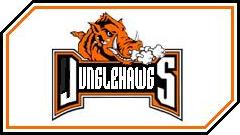 |
|
| Smith steps into a very good job situation, where his chief competition is grizzled (and recently injured) veteran Amani Toomer and slot receiver Sinorice Moss. Dallas takes him here in part because they need to replace Lee Evans (who was traded to Green Bay earlier this offseason). |
1.15 Houston Tethered Swimmers — WR Anthony Gonzalez
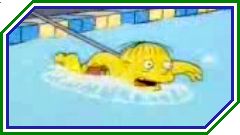 |
|
| The Tethered Swimmers finished 4-10 last year, but could have just as easily gone 7-7 (they suffered three losses by less than five points last year). Jeff Rathburn has made several good deals to make his team a far better one than the motley crew he inherited in 2004. He’s already made trades to upgrade the backfield, acquiring Rudi Johnson and Thomas Jones for Terrell Owens and two #1 picks (2007 and 2008). Now he goes with a WR here to replace Owens.
The Indianapolis Colts drafted Gonzalez to be their slot receiver, replacing the departed Brandon Stokley. And Indy’s #3 WR has, in the past, been more productive than most teams’ #2 wideouts. Stokley himself got over 1,000 yards and 10 TDs from that spot in 2004. And Marvin Harrison isn’t getting any younger (he turns 35 in August). But I have one question: Did he benefit from playing opposite Ted Ginn Jr. (the way Michael Jenkins once reaped the rewards of playing opposite Santonio Holmes), or was it the other way around?
|
1.16 Carolina Convicts — WR Craig Davis
 |
|
|
Mel Kiper Jr. calls Davis a very underrated standout who played in the shadow of Dwayne Bowe: “He’s got excellent size. He’s a physical receiver. He will block as well as any receiver in this draft. He'll catch in traffic.” He joins a potent San Diego offense, which has featured RB LaDainian Tomlinson and TE Antonio Gates; Vincent Jackson and Davis figure to be the Chargers’ top two receivers.
|
2.01 Green Bay Ground Hogs — WR Dwayne Jarrett
 |
|
|
Please don’t compare him to Mike Williams. Jarrett will be more like the guy he replaces on the Carolina Panthers, Keyshawn Johnson (who also went to USC). Mel Kiper, Jr.: “He’s already shown that he can separate. He’s always shown he has good hands.” Personally, I wouldn’t have reservations about anyone who gives Leon Hall a rough day, as Jarrett did in the 2007 Rose Bowl (11 receptions/205 yards/2 TD). And Hall went a round earlier than Jarrett. Green Bay’s WR corps has improved dramatically with the additions of Robert Meachem (1.08) and now Jarrett. Roy who?
|
2.02 Arizona Outlaws — WR Sidney Rice
 |
|
|
Arizona needed help at wideout because the two they picked in Round 1 in 2005 (Troy Williamson, Mike Williams) have both been busts. They get Rice, who finds himself with a very good chance to get a starting gig right away with the Vikings. Coincidentally, both Rice and Williamson were drafted by the Vikings—and the Outlaws. And both come out of South Carolina.
Note to Jeff Zamzow, who drafted Williams two years ago: I apologize in advance to you for mentioning Williams three times in this Wrapup. You see, I follow the Lions, and with the 10th overall pick in 2005, I expected them to take one of two players: OT Alex Barron (Florida State), to replace the departed (and IMHO overrated) Stockar McDougle; or LB Derrick Johnson (Texas), because he was a top 5-caliber pick and two of the Lions’ LBs, Tedy Lehman and Boss Bailey, were far from durable. Even if I knew that Charles Rogers was having substance abuse problems, I still would have taken Barron or Johnson—wide receivers are much easier to come by. Instead, we got an unneeded player who did next to nothing. (And had the Lions taken Johnson, might they have spent their 2006 #1 on Matt Leinart since they wouldn’t have needed Ernie Sims? The mind boggles...)
|
2.03 Cleveland Cellar Dwellers — WR Ted Ginn, Jr.
 |
|
|
In 2006, Ginn showed that he had the hands to go with his incredible speed, and became the second WR to go in the NFL Draft. Problem is, he suffered a foot injury (it’s officially called a “Lisfranc sprain,” and of all the ways for it to happen, it happened during an end zone celebration following his return of the opening kickoff of the National Championship Game for a TD). He'll miss minicamp but is expected to be ready for training camp. When healthy, he’s a threat to “take it to the house” every time he touches the ball, but he’s not terribly big or strong (178 lb.), and he needs to be a more polished route runner.
|
2.04 Detroit Vipers — RB Lorenzo Booker
 |
|
|
His yards per carry average declined in each of his last 3 years at Florida State. On the flip side, his yards per reception improved, suggesting that he could make a very good 3rd-down back. Mel Kiper called him a “poor man’s Warrick Dunn," and Dunn, incidentally, also came from Florida State. Mike Mayock of NFL Network says Booker can create matchup problems like Reggie Bush and Brian Westbrook do. I thought Arizona would take him at 2.02 to handcuff to Ronnie Brown, especially after reading that the Dolphins cleared out the locker of one Ricky “Hooray Weed” Williams, but they went with a need pick/homer pick in Sidney Rice, so I snapped him up here. (Just a few days after making this pick, ESPN reported that Williams tested positive for pot in April.)
|
2.05 Detroit Vipers — QB Drew Stanton
 |
|
|
Critics point to inconsistent play and decision-making, but I say he was simply the victim of a bad system at Michigan State. MSU’s program hasn’t been the same since Nick Saban left, especially after the 2002 season (when Bobby Williams didn't know if he had control of his team). A key issue for him is durability (he injured his knee in 2003 and had a separated shoulder in 2004). One stat in his favor: His completion percentage the last three seasons (64.1, 66.7, 61.0). Note: I believe he’s the first Farmington Hills Harrison High School player to be drafted in the NFL (he graduated from there in 2002; I graduated in 1990 myself.)
|
2.06 Carolina Convicts — QB Kevin Kolb
 |
|
|
The Eagles took him early in Round 2 in one of the bigger swerve jobs (and reaches) of this year’s NFL Draft. Donovan McNabb is recovering ahead of schedule from ACL surgery, and Philly already has A.J. Feeley and Kelly Holcomb as backups. But according to ESPN’s Sal Paolantonio, the relationship between McNabb and the Eagles is strained and McNabb “needs to put in a 16-game season if he hopes to remain with the team beyond this year.”
|
2.07 Tennessee Taz Devils — WR Jason Hill
 |
|
|
Hill considered coming out early after 2005. In one game that season, against California, he racked up 240 yards and 3 TDs on just 6 receptions. He didn’t stand out in 2006, but at the Combine, he raised his stock back up with a 4.32 40-yard dash. I guess it’s true—you never get a second chance to make a good final impression. Hill provides additional depth to Tennessee’s WR corps, and he'll compete against the likes of Michael Jenkins and Peerless Price as he tries to work his way up the depth chart.
|
2.08 Denver Devils — QB John Beck
 |
|
|
I guess you only put up with Tampa Bay Buccaneer QBs for so long, as the Devils have been doing. Beck is the Mountain West conference record holder in passing yards (11,021), touchdowns (79) and completions (885), and he had 17 300-yard plus passing games. The Miami Dolphins took him to be their next starting QB, but NFL.com’s Gil Brandt says not so fast: “He needs to get the ball up higher on his release. He’s most likely a solid backup at the next level. He’s an older player (25—he spent two years on a Mormon mission prior to starting at BYU) with very good character.” As an aside, given that the Dolphins took a WR and a QB with its first two picks, a lot of people would have just as soon taken Quinn at #9 and either Sidney Rice or Dwayne Jarrett at #40.
|
2.09 Cleveland Cellar Dwellers — RB Antonio Pittman
 |
|
|
Pittman declared for the draft a year early because he had nothing to gain by staying another year (he would have lost plenty of carries to Chris Wells, a possible #1 pick in the 2009 TUFF Draft). We were all disappointed to see Pittman fall to round 4 and then land in a situation where he’s buried behind a couple of established veterans (Deuce McAllister and Reggie Bush). Then again, two years ago, Cleveland picked another rookie that fell to round 4 and ended up seemingly buried behind a couple of vets (Julius Jones and Anthony Thomas). You may have heard of him—Marion Barber III.
|
2.10 Indianapolis Hoosier Daddy’s — RB Dwayne Wright
 |
|
|
Wright is a JUCO transfer with great potential but injury problems. I was expecting Cleveland to take Wright (to handcuff to Marshawn Lynch). After the draft, Allen Wilson of the Buffalo News suggested that Wright might vulture some goal line carries from Lynch, although with a home run threat like that, it’s like saying “Lorenzo Neal could steal some goal line carries from LaDainian Tomlinson.”
|
2.11 Dallas Junglehawgs — QB Trent Edwards
 |
|
|
Dallas is collecting QBs the way Bill Parcells collected linebackers (and me, running backs), as they continue to search for a backup for Eli Manning. Edwards arrived at Stanford in 2002 as one of the premier quarterback recruits in the country. Maybe he would have done better if Stanford had actually tried to build a team around him. He was sacked 22 times in the six games he played in last year before missing the rest of the season with a foot injury. I was expecting him to fall to Carolina (as they have J.P. Losman to handcuff Edwards to).
|
2.12 Tampa Bay Meat Goats — RB/FB Brian Leonard
 |
|
|
Mike Mayock, the NFL Network’s draft analyst, ranked Leonard ahead of Michael Bush and Kenny Irons among RB prospects. “I am totally frustrated by all of the people trying to tell me he has to play fullback,” says Mayock. “I've watched a bunch of tape, and to me, he’s an NFL tailback.” Leonard is versatile enough be a fullback or a tailback. Going in Round 2 to the St. Louis Rams meant the Dallas Junglehawgs had two chances to take him as a handcuff to Steven Jackson, but they addressed other needs instead.
|
2.13 Dallas Junglehawgs — TE Zach Miller
 |
|
|
The Junglehawgs get their backup tight end (plus Daniel Graham is a more solid starter now that he’s out of New England). Miller was used more at ASU than Greg Olsen was at Miami, but his 4.8 40-yard dash time at the Combine caused him to drop to Round 2. Still, Miller should be solid, and I would be surprised if he didn’t win the Oakland Raiders’ starting TE job.
|
2.14 Pittsburgh BIG PAPAS — WR Jacoby Jones
 |
|
|
This speedster with long (34”) arms will join a multi-headed battle for the #2 or #3 WR spots in Houston. The competition also includes another speed demon (Jerome Mathis) and a couple of retreads (Kevin Walter, Andre Davis). This could turn out to be a steal—especially if the Texans don’t go after ex-Panther Keyshawn Johnson or future ex-Jet Justin McCareins. Jones is from Lane College, best known for producing the late Fred Lane (no relation), a surprise producer for the Panthers and Colts in the late '90s.
|
2.15 Tampa Bay Meat Goats — RB Kolby Smith
 |
|
|
He got a chance to shine at Louisville last year after Michael Bush broke his leg last fall. If KC, one day, decides to deal RB Larry Johnson, Smith could conceivably be the man to step in for him. If Johnson makes good on his threat to hold out for a new contract, Smith may get a lot more touches than he expected.
|
2.16 Carolina Convicts — RB Garrett Wolfe
 |
|
|
The Bears took him in Round 3 because offensive coordinator Ron Turner compares him to Warrick Dunn, and he could become the third-down back (or perhaps even the “lightning” in yet another “thunder and lightning” duo). Turner also insists that, unlike Darren Sproles of the Chargers, Wolfe is not going to be a special teams player. Chicago obviously had lots of chances to see Wolfe play, as he is from Northern Illinois (the same school as Michael “Burner” Turner).
|
3.01 Minnesota Fats — WR Aundrae Allison
 |
|
|
Like Sidney Rice, Allison is fortunate to be drafted by the Minnesota Vikings, the guys who wish they had kept Hank Baskett III. Scouts, Inc.: “Allison doesn’t have elite speed and he needs to get stronger. On the flip side, he possesses the hands, burst and vision to develop into a productive sub-package receiver in the NFL.”
|
3.02 Green Bay Ground Hogs — PK Mason Crosby
 |
|
|
The odds-on favorite to beat out Dave Rayner, he has a powerful leg (he boomed a 60-yarder as a sophomore at Colorado). It’s not the thin Colorado air, either—his leg is that darn good. Scouts, Inc. noted that when kicking, he needs to get to the ball more quickly or he might have some FG attempts blocked.
|
3.03 Detroit Vipers — PK Justin Medlock
 |
|
|
After going 20-for-35 from 40 yards or more in three seasons, and only 5 touchbacks out of 78 kickoffs last season, Lawrence Tynes’ hold on the Chiefs’ placekicking job is tenuous. Medlock is 25-for-33 from 40-49 yards and 6-for-9 from 50 yards or more in four seasons at UCLA. I took him for two reasons: Phil Dawson has the same bye week as Nate Kaeding this year (and I'm not about to throw that week’s game), and Medlock will be kicking for a better team in warmer weather. (I subsequently dealt Dawson to Carolina for their 4th-rounder next year.) Update 5-22-07: The Chiefs have traded Tynes to the New York Giants, meaning they have given the placekicking job to Medlock.
|
3.04 Houston Tethered Swimmers — WR Laurent Robinson
 |
|
|
Joe Horn, Michael Jenkins and Roddy White may be ahead of Robinson on the depth chart now, but Jenkins and White haven’t done much so far in their careers, so Robinson has a chance. He's a burner (4.38 40yd dash, which is really fast for a 6’2”, 199 lb. guy), and while most of his games were against a lower level of competition, he stepped up against Iowa St. in 2005 (6 receptions for 177 yards and 2 TD) and Kansas St. in 2006 (9 catches for 77 yards).
|
3.05 Baltimore Brown Clowns — QB Troy Smith
 |
|
|
The Brown Clowns finally join the draft (they had traded away their first two picks to Cleveland for WR Steve Smith). Smith, a Heisman Trophy winner, is a playmaker, to be sure, but he’s relatively short and not quite as athletic as, say, Donovan McNabb (when healthy, anyway). A combination of size and off-field issues scared off most NFL coaches, and that is why he fell about as far in this year’s draft as Omar Jacobs did last year.
|
3.06 Carolina Convicts — WR Yamon Figurs
 |
|
|
He had the fastest 40-yard dash at the Combine (4.34), so at the very least, he'll be a kick returner. But at 5’11”, 174 pounds, he is unlikely to be an every-down receiver. And don’t the Ravens still have B.J. Sams to return kicks? Todd Hansen put it very well when he said: “Carolina selected ‘Yeah Man, Go Figure.’”
|
3.07 Tennessee Taz Devils — WR Paul Williams
 |
|
|
The Tennessee Titans took him in Round 3 as part of their efforts to bolster their WR corps. Did Jeff Fisher and Norm Chow read how Scouts, Inc. soured on this guy? Apparently not. Prior to the 2006 season, they said: “Williams has always possessed outstanding natural athleticism, but he is a late-bloomer as a football player... If he continues to improve his recognition skills, consistency as a route runner and focus catching the football during the 2006 season, Williams could skyrocket up the draft board.” A year later, the tune changed: “He struggled to stay healthy and often times looked to be going through the motions as a route-runner on offense... He’s a long-term project and he comes with lots of baggage.” With his durability and mental flags, he'll go from a project to an afterthought if the Titans should nab Keyshawn Johnson.
|
3.08 Pittsburgh BIG PAPAS — RB Justise Hairston
 |
|
|
From a handcuff perspective, this makes perfect sense (the Papas drafted Laurence Maroney last year), and at this pick, it’s neither a reach nor a bargain. Hairston will have to contend with Kevin Faulk and Sammy Morris for touches, and on top of that, he'll be taking on a much higher level of competition than he had in Division I-AA. But we can’t forget that New England has been very good at drafting in the Bill Belichick Era.
|
3.09 Denver Devils — WR Johnnie Lee Higgins
 |
|
|
He’s got speed, hands, leaping ability, and body control, and he was certainly productive at UTEP (2,856 yards and 32 touchdowns in his last three seasons). What he doesn’t have much of is strength or physicality (he’s 186 pounds). But this is still a very good value pick. Higgins has time to get bigger and stronger as he competes against Doug Gabriel and Mike Williams to get up the Raiders’ depth chart.
|
3.10 Indianapolis Hoosier Daddy’s — WR James Jones
 |
|
|
He could be the #3 wideout in Green Bay, and the Packers really like him to take him in Round 3 (making him the 13th WR selected in the NFL draft), so this pick could be a very good bargain. Besides, Ted Thompson also took Brandon Jackson (1.05), so there’s no way I dis this pick.
|
3.11 Baltimore Brown Clowns — RB DeShawn Wynn
 |
|
|
I was considering him at 3.05 (as a handcuff pick), but I decided I'd rather have a future #2 pick. Todd McShay sized up Wynn prior to the National Championship Game between Wynn’s Florida Gators and the Ohio State Buckeyes: “Wynn has the size, power and agility to make an impact in the NFL. It looked as if the ‘light was coming on’ early in his senior season but a lingering knee injury prevented him from finally reaching his full potential. There are also red flags regarding his durability, immaturity and work ethic that will cause him to slip in the 2007 draft.” It didn’t take long for him to get hurt as a pro—he missed the last two days of rookie orientation camp with a calf injury.
|
3.12 Tampa Bay Meat Goats — RB Kenneth Darby
 |
|
|
His 40yd dash time was 4.75, so it’s no surprise that he nearly went undrafted. Gil Brandt of NFL.com says Darby gets by more on quickness than foot speed. Scouts, Inc.: “Darby is an instinctive, quick, tough and physical back that runs bigger than his ‘measurables’ indicate. He also displays adequate versatility in the passing game… Darby will level off as a solid backup in the NFL but he lacks the special qualities of a fulltime starter.”
|
3.13 San Diego Slewage — RB Thomas Clayton
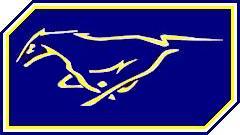 |
|
|
The Slewage, who have spent their recent years dealing future picks for bolster their roster for their annual playoff run, finally get into this draft by dealing their 2008 and 2009 third-rounders to Arizona. I had expected Indy to take Clayton at 3.10 to handcuff to Frank Gore (even if it is more likely that second-year converted QB Michael Robinson will be the #2 RB for the 49ers).
|
3.14 Pittsburgh BIG PAPAS — WR Mike Walker
 |
|
|
Walker tore an ACL late in the 2005 season, but just 14 months after having surgery on that knee, he ran a 4.35 40-yard dash at the Scouting Combine. Last season, his comeback year, Walker caught 90 passes for 1,178 yards and seven touchdowns, despite being less than full speed for half the season. Like another Central Florida alumnus (2006 draft pick Brandon Marshall), Walker is a former defensive back. So let’s see, fourth-round pick, sub-4.4 speed, on a team with no established go-to receiver, and he knows how defensive backs think. That adds up to a very good value at this pick.
|
3.15 Minnesota Fats — QB Tyler Thigpen
 |
|
|
The Vikings took this guy out of Coastal Carolina, a Division I-AA school. His mobility and arm strength were what possessed the Vikings to take him over Jared Zabransky, Tyler Palko and Chris Leak. At a workout in front of pro scouts, standing flat-footed, he launched a pass 67 yards. That was good enough to earn the right to compete against Drew Henson to hold the clipboard for the Vikings.
|
3.16 Dallas Junglehawgs — PK Nick Folk
 |
|
|
The Junglehawgs took Folk in their latest effort to replace John Hall (released by the Redskins due to excessive injuries). Folk may compete to be Dallas’ placekicker, or the Cowboys may keep Martin Gramatica as their kicker and Folk could be a kickoff specialist. Scouts, Inc. says the latter is more likely: “Folk has the power to connect on long-distance field goal attempts and to kick off, but there are some concerns about his accuracy.”
|
4.01 Minnesota Fats — TE Martrez Milner
 |
|
|
I'm not sure why the Falcons took Milner, unless they felt they needed a better backup for Alge Crumpler and/or maybe they plan on using two-TE sets (I don’t know Crumpler’s contract status). I imagined the Brown Clowns taking him as a handcuff pick. But Milner is relatively unpolished, according to his Scouts, Inc. profile, and his hands are too unreliable at this point (double catches and drops—for example, he had three drops against Florida last year).
|
4.02 Arizona Outlaws — RB Gary Russell
 |
|
|
In 2005, he rushed for 1,130 yards despite playing behind Laurence Maroney, and it looked like he would inherit Maroney’s job. Then he missed 2006 due to academic problems. He only had 24 carries in 2004, so for all intents and purposes, 2005 was the only year he played college football. At the Scouting Combine, he had terrible 40yd times (4.80 and 4.84), giving him more in common with Lions WR Mike Williams (missed a year, out of shape, questionable desire) than with Maroney. Arizona—quick question, why not Selvin Young (who would have been a handcuff to Travis Henry)? I realize that owner Jeff Zamzow is from Minnesota, and Russell was a Minnesota Golden Gopher, but passing up a handcuff for a “homer” could come back to bite him.
|
4.03 Cleveland Cellar Dwellers — PASS
 |
|
|
At the time, the Cellar Dwellers had one vacant roster spot, and weren’t bidding on any free agents, so I was expecting them to take somebody. The New Orleans Chocolate City was quick to point out that, as they had traded their first three draft picks, they would have bought this pick for 10 TUFFs—which could, for example, get you 10 players that nobody else bids on.
|
4.04 New Orleans Chocolate City — WR Isaiah Stanback
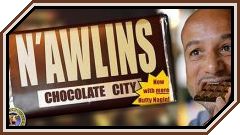 |
|
|
N'Awlins traded their first three picks last year for Tony Romo, Eric Moulds and Antowain Smith. As of May 11, only one of those three has a job in the NFL. So now GM Tommy Hartdegen is scrambling to get any rookies they can. At least he’s getting value out of these lowly picks. Ed Werder of ESPN says the Cowboys view Stanback as a WR conversion project (a la Drew Bennett), rather than a QB or even a “Slash”-type player. At 6’3”, 218 pounds, he is similar in size to Bennett. But the Cowboys aren’t very deep at WR, Terry Glenn is getting up there in age, and Crayton’s contract is for just one year. Short-term, Stanback is a taxi squad player this year because he suffered a Lisfranc’s foot injury late last season.
|
4.05 Detroit Vipers — RB Darius Walker
 |
|
|
He has some speed and can catch the ball, and his yards-per-carry average improved over his three years at ND, but he didn’t dazzle at the Combine. Honestly, I don’t know why he wasn’t drafted. Slightly undersized at 5’10”, 208 lb. He will battle Ron Dayne, Wali Lundy, Samkon Gado and Chris Taylor for whatever touches Ahman Green doesn’t get. He originally had a deal with Chicago, but it fell through when he was informed the Bears don’t plan to keep more than three running backs on their roster. I was surprised (and relieved) that Dallas didn’t take him at 3.16 to handcuff to Green. The Texans switched to a zone-blocking scheme last year, and if it can help Nell Carter—oh, excuse me, Ron Dayne—then it can help Walker. Since Dallas had the next pick, I expected him to send me an e-mail saying “You bastard” (like he did when I selected T.A. McLendon at 4.13 in 2005).
After taking Walker, I sent Kevan Barlow to San Diego for 2 TUFFs. If he makes me look bad as a member of the Slewage, great. But I had to make room for the new blood.
|
4.06 Dallas Junglehawgs — WR Jordan Kent
 |
|
|
A very raw prospect (didn’t see much action on the gridiron in either college or high school), but based on what NFL Draft Countdown says about him, I can’t blame the Seahawks or Mike Scott for taking him: “Has outstanding height and bulk with long arms...Tremendous natural athlete...Just oozes potential...Phenomenal leaper.” That said, he’s probably headed to the taxi squad this year.
|
4.07 New Orleans Chocolate City — WR Roy Hall
 |
|
|
Another product of the wide receiver factory that is Ohio State. He’s 6’2”, 229 pounds and has 4.41 speed, and being drafted by the Colts is a huge plus. But didn’t get more than 230 yards receiving in any of his four seasons (because he was playing on the same team as Michael Jenkins, Santonio Holmes, Ted Ginn and Anthony Gonzalez). Maybe he should have transferred to another school—Drew Stanton would have been thrilled to have him as a target at Michigan State.
|
4.08 New Orleans Chocolate City — RB Selvin Young
 |
|
|
Young was a promising back with an intriguing size/speed combination. However, those injuries led him to lose carries to younger Jamaal Charles. He ran a 4.60 at Texas’ Pro Day, which is relatively slow for a RB, but Young showed good agility and explosiveness at that workout. He also displayed solid hands when catching the ball during position drills. He’s currently the Broncos’ #3 tailback behind Travis Henry and Mike Bell. The Chocolate City is pleased to have him to handcuff to Mike Bell (another undrafted FA Mike Shanahan signed in his ego-driven quest to prove that anybody can get 1,000 yards in the zone-blocking scheme).
|
4.09 Denver Devils — RB Ahmad Bradshaw
 |
|
|
He almost went undrafted because he’s on the small side (5’9”) and doesn’t have top-end speed. But when you can handcuff him to your other Giants RBs (as Rick Dailey does here), then he’s worth that 4th-round pick, easily. Besides, nobody’s sure how much is left in Reuben Droughns’ tank. |
4.10 Houston Tethered Swimmers — TE Ben Patrick
 |
|
|
Houston acquired this pick from Indianapolis in exchange for PK Matt Bryant (Indy needed an extra kicker as insurance against Dave Rayner losing his job). Two years ago, the 4.10 pick was also used on a Cardinals tight end. Now, I'm not entirely sure what the Cardinals’ selection of Patrick means for Leonard Pope, the big 6’8” guy with the freakish wingspan and leaping ability, but I'm guessing Pope should worry. Pope had a disappointing rookie season with 16 receptions for 161 yards, and most tight ends make more of an impact than that in their first years in the NFL. Even guys like Jermaine Wiggins and Bo Scaife did better in their first year.
|
4.11 Baltimore Brown Clowns — RB/FB Jason Snelling
 |
|
|
A pass-catching fullback that took over as tailback for Virginia last year. Warrick Dunn is 32 now; Snelling and Jerious Norwood could be a future “thunder and lightning” combo for the Atlanta Falcons by the time Dunn hangs up the cleats...
We can all dream, can’t we? But seriously, check out www.nfldraftguys.com. There are a few experts there that thought very highly of Snelling as a "bowling ball in cleats”-type of back.
|
4.12 Tampa Bay Meat Goats — TE Dante Rosario
 |
|
|
He’s only played tight end for two years (he was a running back for his first two years at Oregon). His 4.76 speed suggests that Oregon did him a hell of a favor by moving him to tight end. At his present weight (244 lb.), he could also be a fullback or an H-back.
|
4.13 Dallas Junglehawgs — RB Germaine Race
 |
|
| Race played at Pittsburg State, a Division II school in Kansas. Race is the leading scorer on any level of NCAA football with 658 points. But he's a longshot to make the NFL because he’s slow (4.66 40yd dash) for his size (5’10”, 218 lb.), and in all likelihood, that isn’t going to cut it. So long, Germaine, thanks for playing, here’s a copy of the TUFF board game as a parting gift.
|
4.14 Indianapolis Hoosier Daddy’s — WR Chris Davis
 |
|
|
Another WR drafted by the Tennessee Titans. 5’10”, 181 pounds (and NFL teams have had some recent success with similarly-sized receivers, like Steve Smith of the Panthers and Santana Moss of the Redskins). At the very least, he could be a kick returner and a slot receiver.
|
4.15 Arizona Outlaws — QB Jeff Rowe
 |
|
|
A handcuff pick (same team as Carson Palmer). This is much more sensible than Gary Russell (4.02). Rowe is taller than the average QB at 6’5”. His completion percentage improved over his last three seasons with Nevada, which is generally good to see. He'll have to adjust from the shotgun offense they ran at Nevada to a pro-style offense.
|
4.16 Tennessee Taz Devils — QB Jordan Palmer
 |
|
|
Cleveland acquired this pick from Dallas last year in exchange for a 2006 fourth-rounder, probably hoping it would be high in the draft order, but we all know what the Junglehawgs did. Stuck with another low draft pick, this time, Cleveland sold it to Tennessee, and they take Palmer to handcuff to Jason "Dougastalgia" Campbell. Palmer, the younger brother of Carson Palmer, is considered to be a developmental prospect at this point. Like Rowe, he was picked in Round 7, is tall (6’5”), but is relatively slow.
|





















































